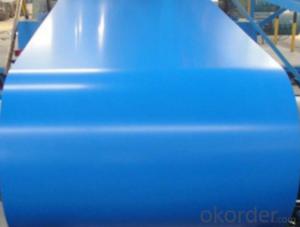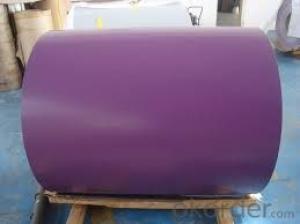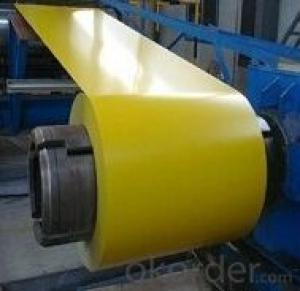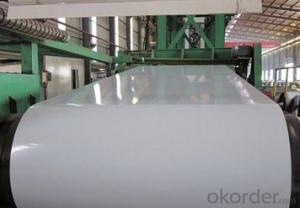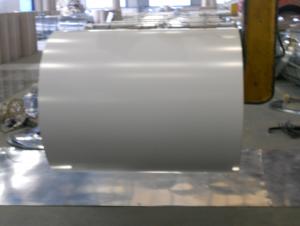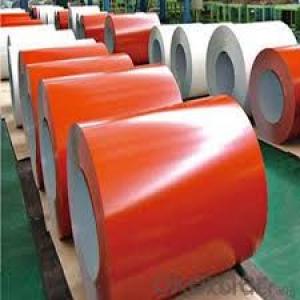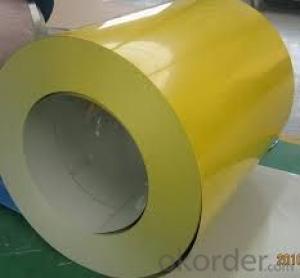Prepainted galvanized coil/prepainted sheets/PPGI/Color Coated steel
- Loading Port:
- Tianjin
- Payment Terms:
- TT OR LC
- Min Order Qty:
- 25 m.t.
- Supply Capability:
- 200000 m.t./month
OKorder Service Pledge
OKorder Financial Service
You Might Also Like
1.Structure of Prepainted Galvanized steel Coil :
With Gi as base metal, after pretreatment (degrease and chemical treatment) and liquid dope with several Layers of color ,then after firing and cooling, finally the plate steel is called pre-painted galvanized steel ( PPGI) .Pre-painted galvanized steel is good capable of decoration ,molding ,corrosion resistance
Main Features of Prepainted Galvanized steel Coil:
• Excellent process capability
• Smooth and flat surface
• Workability, durability
• Excellent heat resistance performance
• High strength
• Good formability
• Good visual effect
2.Prepainted Galvanized steel Coil Images
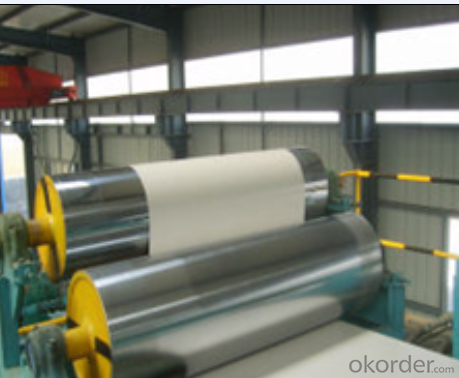
3. Prepainted Galvanized steel Coil Specification
Standard:ASTM, GB,JIS,JIS G3302 ASTM 755 EN10169
Grade: DX51D CGCC CS
Thickness: 0.13mm~3.0mm,
Width: 1250,600-1250mm
Coil weight:3-12 MT
Coil ID:508/610mm
Chemical composition:
C | Si | Mn | Cr | Ni | P | S |
0.150 | 0.476 | 11.231 | 12.50 | 0.900 | 0.039 | 0.010
|
4.Application for Prepainted Galvanized steel Coil
Outdoor: sandwich panel roofing, roofing structure, surface of sheet of balcony ,frame of window ,door, door of garage, roller shutter door, booth ,cabana, refrigerated wagon and so on .
indoor: frame of door, light steel structure of house, sliding door, folding screen ,ceiling ,internal decoration of elevator
5.FAQ of Prepainted Galvanized steel Coil
We have organized several common questions for our clients,may help you sincerely:
1.How do you control your quality
We have established the international advanced quality management system,every link from raw material to final product we have strict quality test;We resolutely put an end to unqualified products flowing into the market. At the same time, we will provide necessary follow-up service assurance.
2.how long we will receive the goods ?
After receiving your deposit or workable lc ,our normal shipment date is 15-20days,and it takes around 28 days to reach your port of destination. But is up to different destination
3. what is your moq
Normally our moq is 25per size ,but it is up to different size
- Q: I am in the market for a good hunting knife under $100. I am primarily looking for a knife that will keep it's edge. What type of steel should I be looking for?
- Get a Kershaw hunting knife. Kershaw uses only good quality knife steel and they have plenty of hunting knives under $100.
- Q: What are the challenges in the production of steel coils?
- The production of steel coils faces several challenges. Firstly, one of the major challenges is ensuring consistent quality throughout the production process. Steel coils need to have uniform thickness, width, and flatness. Achieving this consistently can be challenging due to variations in raw materials, equipment, and operating conditions. Another challenge is managing the high temperatures involved in the production process. Steel coils are produced by heating steel slabs or billets to extremely high temperatures and then rolling them into coils. Maintaining the required temperatures and ensuring proper cooling can be a complex task, as any deviations can lead to inconsistencies in the final product. Furthermore, the production of steel coils requires a significant amount of energy. The steel industry is one of the largest energy consumers globally. Reducing energy consumption while maintaining production efficiency is a constant challenge. Implementing energy-efficient technologies and optimizing processes are necessary to address this challenge. Moreover, the production of steel coils generates a considerable amount of waste and emissions. Steel manufacturing involves various chemical reactions and releases pollutants such as carbon dioxide, sulfur dioxide, and particulate matter. Managing and minimizing these emissions to comply with environmental regulations is a significant challenge for the industry. Additionally, steel coils are often produced in large quantities, requiring efficient logistics and transportation systems. Ensuring timely delivery and minimizing damage during transportation can be a challenge due to the weight and size of the coils. Lastly, the steel industry faces market challenges, including fluctuating prices of raw materials, competition from other materials, and global economic conditions. Adapting to market demands and maintaining competitiveness is crucial for the sustainable production of steel coils. Overall, the challenges in the production of steel coils include maintaining consistent quality, managing high temperatures, reducing energy consumption and emissions, optimizing logistics and transportation, and adapting to market dynamics. Addressing these challenges requires continuous innovation, technological advancements, and a focus on sustainability.
- Q: What are the different types of steel coil loading and unloading methods used during processing?
- There are several types of steel coil loading and unloading methods used during processing. Some common methods include crane lifting, fork truck handling, coil transfer cars, and overhead cranes with C-hooks. Each method is chosen based on factors such as the size and weight of the coils, the layout of the processing facility, and the efficiency and safety requirements of the operation.
- Q: How are steel coils used in the manufacturing of agricultural silos?
- Steel coils are used in the manufacturing of agricultural silos as they are rolled into large cylindrical shapes to form the outer structure of the silo. These coils provide strength, durability, and resistance to external elements, ensuring the silo can withstand the weight of the stored agricultural products and protect them from moisture and pests.
- Q: Can steel coils be used in the food processing industry?
- No, steel coils are not typically used in the food processing industry due to the risk of contamination and potential health hazards. Food-grade materials such as stainless steel are preferred for their hygienic properties and ability to withstand high sanitary standards.
- Q: Can steel coils be used in the production of consumer goods?
- Yes, steel coils can be used in the production of consumer goods. Steel coils are versatile and commonly used in various industries, including consumer goods manufacturing. They are often used as raw materials in the production of appliances, automotive parts, construction materials, furniture, and packaging. The durability and strength of steel coils make them suitable for these applications, ensuring the quality and longevity of the consumer goods produced.
- Q: Can steel coils be stamped?
- Yes, steel coils can be stamped. Stamping is a common manufacturing process used to shape and cut steel coils into desired forms and designs.
- Q: How do steel coils contribute to the manufacturing of oil and gas equipment?
- Steel coils are an essential component in the manufacturing of oil and gas equipment. These coils are typically made from high-quality steel that is durable, strong, and resistant to corrosion, making them ideal for withstanding the harsh environments and conditions encountered in the oil and gas industry. One of the primary applications of steel coils in oil and gas equipment manufacturing is in the fabrication of pressure vessels. Pressure vessels are crucial components used for storing and transporting various fluids and gases under high pressure. Steel coils are used to form the cylindrical shells of these vessels, providing the necessary strength and structural integrity to withstand the internal pressure. Steel coils are also utilized in the construction of oil and gas pipelines. These pipelines are responsible for transporting vast quantities of oil and gas over long distances. Steel coils are used to manufacture the pipes that make up these pipelines, providing the necessary strength, durability, and resistance to corrosion. The coils are rolled and welded to form seamless or welded pipes, which are then coated or lined to prevent corrosion and enhance their longevity. Furthermore, steel coils are instrumental in the production of drilling equipment used in the extraction of oil and gas. This equipment includes drill bits, casings, and wellheads, which are crucial for drilling and completing wells. The coils are used to fabricate these components, ensuring they can withstand the demanding conditions encountered during drilling operations. In addition to their structural applications, steel coils are also used in the manufacturing of ancillary equipment such as tanks, storage containers, and heat exchangers. These components play a vital role in the processing, storage, and distribution of oil and gas. Steel coils provide the required strength and durability to handle the harsh conditions and corrosive substances encountered in these processes. Overall, steel coils are indispensable in the manufacturing of oil and gas equipment. Their strength, durability, and resistance to corrosion make them a preferred choice in the industry. By contributing to the fabrication of pressure vessels, pipelines, drilling equipment, and ancillary components, steel coils ensure the safe and efficient extraction, processing, and transportation of oil and gas.
- Q: What are the common defects in steel coil finishes?
- Steel coil finishes can be affected by various defects that can impact both their appearance and functionality. Before using or selling the coil, these defects may need to be addressed. One common defect is coil breaks, where the steel strip breaks during winding or unwinding. If not dealt with, this defect can cause a discontinuity in the coil's surface and potentially lead to further damage. Another defect is edge wave, which refers to a distortion or waviness at the edges of the coil. This can occur during the rolling or cooling process and can affect the coil's flatness and uniformity. Corrosion is another issue that can arise if steel coils are not properly protected or stored. This can result in rust and degradation of the steel, impacting its strength and appearance. Streaks and stains can appear on the surface of steel coils due to improper cleaning or contamination during production. These defects can affect the aesthetic appearance of the steel and may need to be addressed before use. Scratches and dents can occur during handling, transportation, or storage of steel coils. These defects can impact the flatness and surface quality of the steel and may require repairs or adjustments. If a coating or paint is applied to the steel coil, several defects can arise, including blistering, peeling, or uneven application. These coating defects can affect the durability and appearance of the steel. It's important to note that the severity of these defects can vary, and different methods of repair or mitigation may be needed. Regular inspections and quality control measures can help to identify and address these defects before they become more significant issues.
- Q: How are steel coils used in the manufacturing of airbags?
- Steel coils are used in the manufacturing of airbags as they provide the necessary structural support and strength to ensure the airbags deploy effectively during a collision. The coils are typically placed within the airbag module to help maintain its shape and prevent it from collapsing on impact, ensuring the airbag can rapidly inflate to protect occupants in a vehicle.
Send your message to us
Prepainted galvanized coil/prepainted sheets/PPGI/Color Coated steel
- Loading Port:
- Tianjin
- Payment Terms:
- TT OR LC
- Min Order Qty:
- 25 m.t.
- Supply Capability:
- 200000 m.t./month
OKorder Service Pledge
OKorder Financial Service
Similar products
Hot products
Hot Searches
Related keywords
